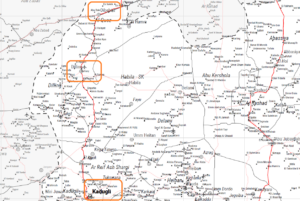Surviving on ambaz in North Darfur – when animal fodder becomes food for people

Children in El Fasher eat a meal of 'ambaz' Jul 2025 (Photo: Radio Dabanga)
Report by Abdel Moneim Madbo
In one of the besieged neighbourhoods of El Fasher, Nafisa sits on the ground in front of a clay stove (kanun) with a boiling pot on top of it; she slowly stirs it, trying to turn it into something resembling porridge. Her little daughter watches her with eyes sunken with hunger, asking: “Mama, is this the cow’s food?” The mother sighs and whispers: “Now it’s our food… God help us.” It’s ambaz, a byproduct of peanut production usually used as animal fodder, which has become a staple meal for Nafisa, her children, and most of El Fasher’s residents after the RSF siege consumed everything, leaving only hunger gnawing at the stomachs of the young and old of the city.
Exhausted by the siege, bombardment, and hunger, residents are now faced with two choices: starve to death or eat what was previously inedible. Ambaz is no longer just animal feed used to fatten livestock; it has become the only available meal, given the food shortage in the city, which has been under siege for more than a year by the RSF. This has cut off trade routes and prevented the entry of food, medicine, and fuel.
Over time, food supplies ran out, bakeries ceased operations, and prices for every available commodity soared beyond the reach of ordinary people. The humanitarian crisis transcended expectations, and the city became a terrifying mirror of what communities can become when supplies are cut off and the world’s doors are closed to them. With humanitarian organisations absent, residents began searching for alternatives for survival…and the ambaz meals were born.

(File photo: Sreative Commons)
From animal fodder to food for people
Ambaz is produced by pressing oilseeds such as peanuts, sesame, or sunflower. It has been used for decades in Sudan as animal feed, either alone or with the addition of other ingredients, due to its high protein content and lower price compared to manufactured feed.
“We used to grind it and mix it with dry herbs to feed our livestock,” says Nafisa, a widow and mother of four. “Today, we grind it and mix it with water for our children.” She adds, “These days, obtaining ambaz has become difficult due to the danger of searching for it, its high price, and the fact that we are running out of money.”
While Hajja Mariam Um Dour, a mother of five, tells Radio Dabanga about their dependence on ambaz to cope with hunger, “Every day I cook ambaz for my children. We have nothing else to eat. Sometimes I put a little salt in it so they can eat it.” She adds with regret, “My children are starving, and I cry most of the time when they ask me for food. Sometimes I tell them to be patient, God willing, in the coming days they will have something to eat. But in truth, I don’t know when this suffering will end.”
Her neighbour in the shelter, Zahraa Ibrahim, a mother of two, shares her suffering and tells Radio Dabanga, “The ambaz has become everything. We don’t have money to buy food, whose prices have skyrocketed.” She adds with regret, “I cook ambaz for them until they sleep, and I cry in my heart because I cannot offer them anything better. I fear for their malnutrition, and I fear that one day I will find them unable to move.”
Health risks
Nutritionally, ambaz contains a fair amount of protein and fibre, according to nutrition experts, but it lacks essential vitamins and minerals needed by the human body, especially children and pregnant women. Furthermore, storing ambaz in unsanitary conditions leads to the growth of toxic fungi that produce aflatoxin, which causes serious health problems, including liver damage, malnutrition, and even cancer in cases of chronic poisoning. Aflatoxin is a natural toxin and has been classified as a Class 1 carcinogen by the International Agency for Research on Cancer (IARC).
A nutrition expert stated that using ambaz as a human food provides the body with protein, but eating and digesting it is very difficult. He added in an interview with Radio Dabanga, “because of the fat and fibre content, a person cannot eat a large amount of ambaz. He is satisfied with only what satisfies hunger,” about a cup of tea, after cooking it over a fire. He pointed out that ambaz is a nutritional component and not a meal, as it does not contain other nutrients. The nutrition expert warned that eating ambaz alone for a long period of time could lead to malnutrition due to a deficiency of other nutrients, and could cause food poisoning.” “What is more dangerous is that the stored ambaz contains aflatoxin, a carcinogenic fungal toxin.”
Government procedures
Amid the crippling siege of El Fasher, the governor of North Darfur claimed that what he described as brokers and traders were hoarding goods and stockpiling them to raise prices. At the same time, he announced the formation of a special committee to control the markets, with directives to take strict measures against those proven to be involved. The governor gave the hoarding traders a 72-hour deadline to release their stockpiled goods to the market, threatening to confiscate them and distribute them free of charge to the public if they did not comply. He stated that the storage locations were known to state authorities.
Unbearable conditions
Due to the tragic situation facing the residents of El Fasher, the governor of North Darfur issued an appeal last week, stating that the humanitarian and living conditions in the city have become unbearable, and that the humanitarian situation has deteriorated beyond what it should be. He added, “There is a scarcity of food supplies and rising prices, to the point that a quarter of a gram of millet has reached SDG 500,000. Despite this, it is not available in the markets.” Bakhit stressed that any statements about the poor conditions in El Fasher are the reality and not exaggerated; in fact, they are worse than that. He stressed the need to lift the siege on the city as soon as possible to save the civilians.
In July, UN Secretary-General António Guterres said that the residents of El Fasher were starving and in an extremely difficult situation. He stressed the need to secure a truce to deliver aid, and that it should be agreed upon in advance in order to “prepare a massive aid delivery operation to the city.” According to the UN News website, Guterres said that he had contacted the warring parties in Sudan to secure a humanitarian truce that would address the tragic situation in El Fasher. However, these efforts yielded no results.
Calls to leave
Meanwhile, the RSF and leaders of movements affiliated under the “Ta’sees” coalition are calling on El Fasher residents to safely leave the city, which has been witnessing ongoing fighting. According to the International Organization for Migration’s Displacement Tracking Matrix, approximately 600 people have been displaced from El Fasher to cities in the northern state in just two weeks. Meanwhile, the General Coordination of Displaced Persons and Refugees in Darfur revealed that the number of people fleeing El Fasher and Abshok camp is increasing daily.
Meanwhile, the North Darfur government, the armed forces leaders, and their allies in the joint force are urging people to remain steadfast and not respond to calls to leave the city despite the circumstances they are experiencing. In press statements, North Darfur Governor Hafiz Bakhit described the calls made by El Hadi Idris and El Tahir Hajar as cheap propaganda aimed at recruiting young people into the ranks of the RSF.
In a city besieged by war and consumed by hunger, food is no longer a luxury, but a daily battle for survival. Bound by the siege and the spectre of famine, the people of El Fasher resist, scooping up enough ambaz to sustain their lives while pinning their hopes on promises of a truce that may never come and on humanitarian appeals that fail to materialise. With each new dawn, the question remains: How long can people endure food that wasn’t intended for them?











 and then
and then